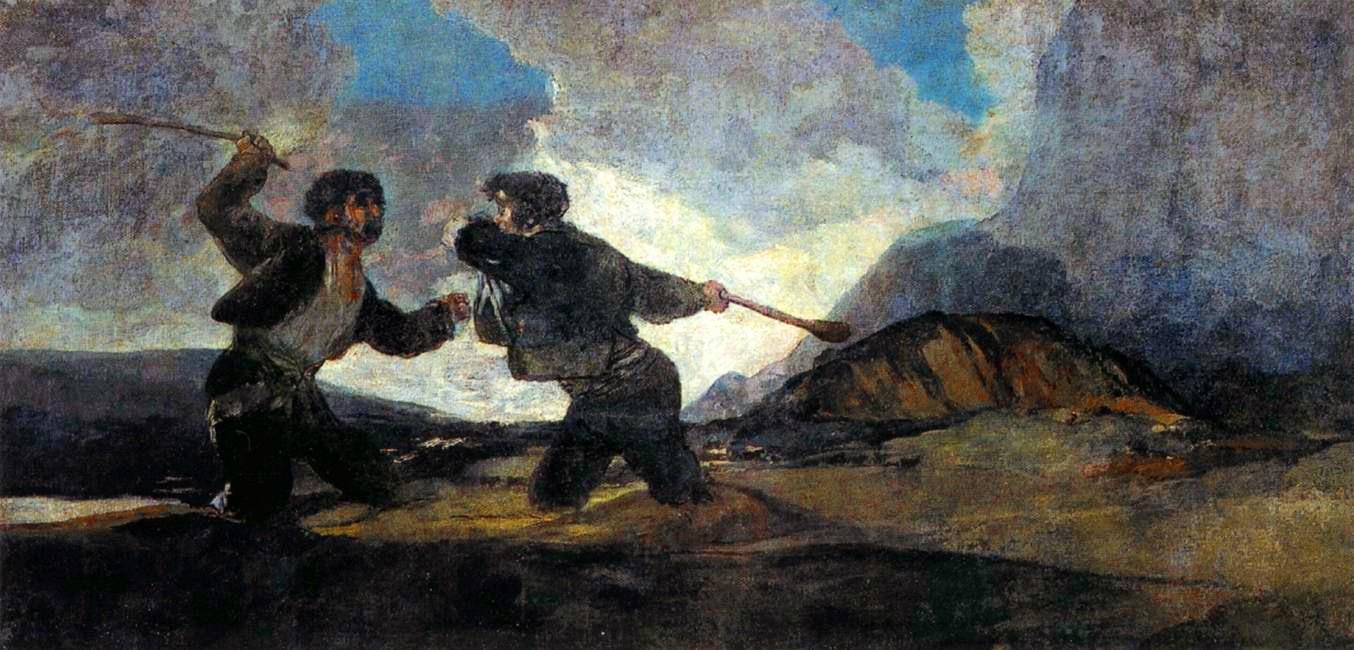
The painting I’ve chosen is the Fight with cudgels, by Francisco de Goya. It was painted on the walls of a house called Deaf Man’s Villa from 1820 to 1821. It‘s one of the Black Paintings. It was really damaged because it was transferred from the wall to a canvas by a rudimentary technique. Its dimensions are 123 x 266 cm. It was also called The Foreigners or Drovers .
DESCRIPTION
The painting shows a countryside scene, where two men are striking one another with cudgels. We can see the transparency and clarity of the color by the degradation of the painting. We can’t see the men´s complete legs. The legs seem to be buried in high grass or in mud. Goya didn’t paint this: the ‘burial’ was made in the restoration of the painting by Martínez Cubells. The man on the left is stronger and his face is spotted with blood. His opponent has the left arm raised to protect his face. Both are wearing the typical clothes of that time. In the background we can see the countryside in different ochre and reddish tonalities. The picture seems to be an allusion to the Spanish civil wars.
The radiographic studies and the comparison with old photos shows that the painting was modified in the restoration Martínez Cubells did.
In this image we can compare the original state
of the painting in the Deaf Man’s Villa and its present state:
ANALYSIS
This painting was made during Ferdinand VII’s reign. Goya was a Francophile and he had liberal ideas. When Goya made this painting the liberals were fighting against the absolutists.
Since its creation the painting has been interpreted as a fight between Spaniards. Some experts of the 19th century have seen this painting as the depiction of a custom of the Spanish countryside. But Spanish experts give to it a more symbolic meaning: the unsparing violence, the disputes between men and the civil wars.
The characters are in the foreground, as in the War Disasters. They are illuminated against the backlight, resource that was the opposite to the common way of painting people. This was to represent the moment of dawn in which this type of fights were carried out. The men were painted in subdued color, in contrast with the colorful forest and the blue sky.
The composition is off-centre, the figures are displaced to the left and they leave a big amount of space on the right. This off-centre composition is also opposed to the neoclassicist and academic painting and was usually used by Goya in the Black Paintings. This technique was based on the use of movement and loose brush-strokes and powerful lines, typical in romanticism.
The painting was transferred from its original location on the wall by Salvador Martinez Cubells, at the request of Baron Émile Erlanger, a French banker, who tried to sell it with all the Black Paintings to the 1878 Paris World Fair, but he didn’t find a buyer and in 1881 he donated the paintings to El Prado Museum in Madrid.
I like this painting because for me it reflects that the world is really beautiful and the human beings are damaging it with their silly disputes and with our selfishness.
Sources:
http://es.wikipedia.org/wiki/Duelo_a_garrotazos
http://www.museodelprado.es/
http://www.wordreference.com/
http://blogs.20minutos.es/martinezsoler/tag/duelo-a-garrotazos/
Los Grandes Genios del Arte –Goya, Biblioteca el Mundo
http://www.fundaciongoyaenaragon.es/goya/obra/catalogo/?ficha=664

Hello Juan,
ReplyDeleteYour final marj is 7. See you!
Sorry: mark
ReplyDelete